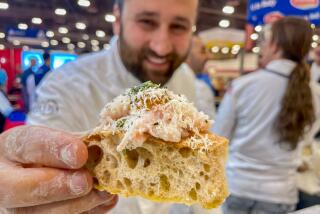This ancient bean is found everywhere in Italy. And you should know about it

- Share via
Every fan of cicerchia has a story of discovery. Mine stretches back a couple of years ago when I visited the organic Bio Alberti Farm, which sat on 1,200 acres of rolling hills near the tiny village of Poggio Aquilone in Umbria.
The picturesque tour was conducted by the owner’s son, who loaded us into his white Fiat and drove us around the entire property, making frequent stops so that we could wander through legume fields rippling in the light breeze. It was there I was introduced to a bean called cicerchia, sometimes known as chickling pea, which when dried looked like a corn nut or an old tooth.
Cicerchia is an ancient legume — it predates grain-based agriculture — that has experienced a resurgence of popularity over the past 15 years or so thanks to the Slow Food movement. Today cicerchia is so common in Italy you can find it on any supermarket shelf. In the States, among people in the know, it’s as exciting as evoking the name of a little-known but beloved band.

Newsletter: Sign up for the Tasting Notes newsletter
I did some light Googling when I got home and learned — uh oh — that if you eat it daily for a period of months it releases a dangerous neurotoxin, the kind that causes irreversible nerve damage, even paralysis. Later, when I mentioned that last harrowing tidbit to chef April Bloomfield, a cicerchia lover, she made a good point: “Favas are the same. It’s just moderation.”
When Bloomfield arrived to cook in New York (she’s originally from the U.K.), chef Cesare Casella gave her a bag of cicerchia as a gift. “I fell in love with them instantly,” said Bloomfield, who said she likes to serve them as “a silky purée” along with braised spiced short ribs. “Once they are cooked, they taste like a pea crossed with a chickpea. Even though they are dry, they have a certain freshness.”
I found out about Bloomfield’s devotion when chef Chad Colby of the recently opened Antico posted a bowl of bright green cicerchia on his Instagram feed. (Bloomfield’s comment on his post read: “OMG. My fave. Never had those fresh. I imagine they will be epic?”)
At Chad Colby’s new restaurant Antico, the pastas are remarkable and the ice cream possibly the best in Los Angeles.
Colby brought beans home from Italy, planted a dozen of them in his home kitchen garden, then waited. The yield from 12 plants allowed for cicerchia to be on the menu at Antico for only a few shifts. “They were sweet, like peas,” Colby said. “And the tendrils and flowers were exceptional.”
When Bloomfield makes a pot of cicerchia, she takes a minimalist approach, cooking them in water instead of broth, seasoning them with salt as they cool down, then finishing them off with a touch of olive oil. “It’s nice to have an unadulterated pure bean flavor,” she said.
I did the best I could to translate a recipe I found on the back of one of the cicerchia packets that I’d tucked into my suitcase on a recent trip to Umbria. I soaked them for 24 hours and then simmered them in salted water with some fresh oregano and mint leaves, garlic, a single carrot, a wedge of onion and a stalk of celery. Given my creaky Italian, I can’t swear that I followed the recipe correctly. But they came out perfectly, delicious and grassy-tasting. Something you’d want to eat lots and lots of but hopefully in moderation.
Currently, cicerchia is so popular in Italy, you can find it on the shelves of any supermarket. Though the cicerchia craze hasn’t hit Los Angeles yet, ask for it at Italian specialty shops and most will order it special from their regular import purveyor.
To order cicerchia
More to Read
Eat your way across L.A.
Get our weekly Tasting Notes newsletter for reviews, news and more.
You may occasionally receive promotional content from the Los Angeles Times.











